Analysis: Share Management Letter for Alexander P Spencer's Estate
VerifiedAdded on 2023/06/12
|6
|1648
|122
Report
AI Summary
This management letter advises George Spencer, the sole executor and beneficiary of his father Alexander P. Spencer's estate, on whether to sell inherited shares in Commonwealth Bank and National Australia Bank directly or transfer them to his name first. The letter outlines the financial implications, including capital gains tax (CGT) and stamp duty, associated with each option. Transferring the shares incurs CGT and requires extensive paperwork, while selling directly minimizes costs and paperwork. The letter recommends selling the shares directly to avoid tedious documentation and hefty costs, providing a more convenient and economically sound approach for George Spencer.
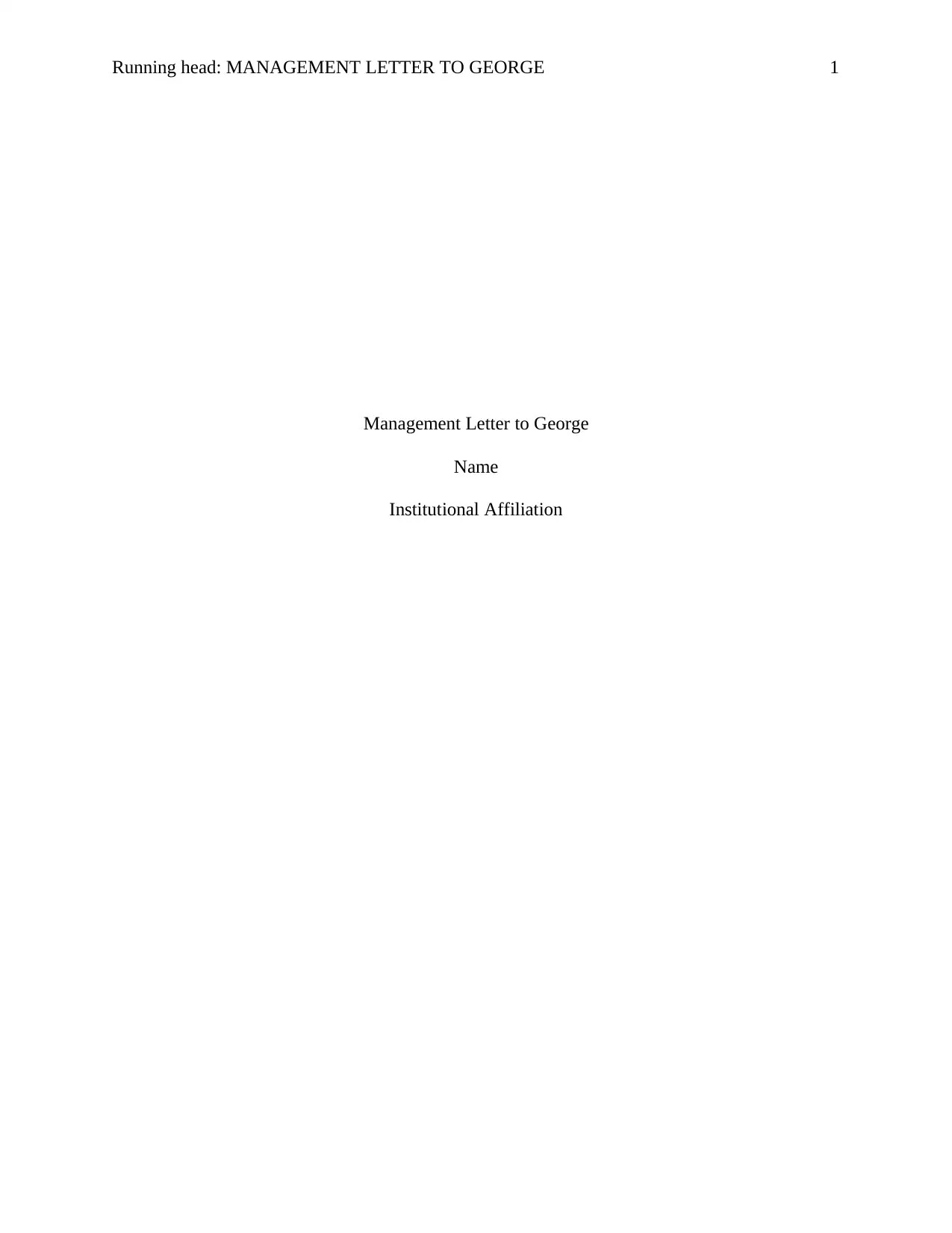
Running head: MANAGEMENT LETTER TO GEORGE 1
Management Letter to George
Name
Institutional Affiliation
Management Letter to George
Name
Institutional Affiliation
Paraphrase This Document
Need a fresh take? Get an instant paraphrase of this document with our AI Paraphraser
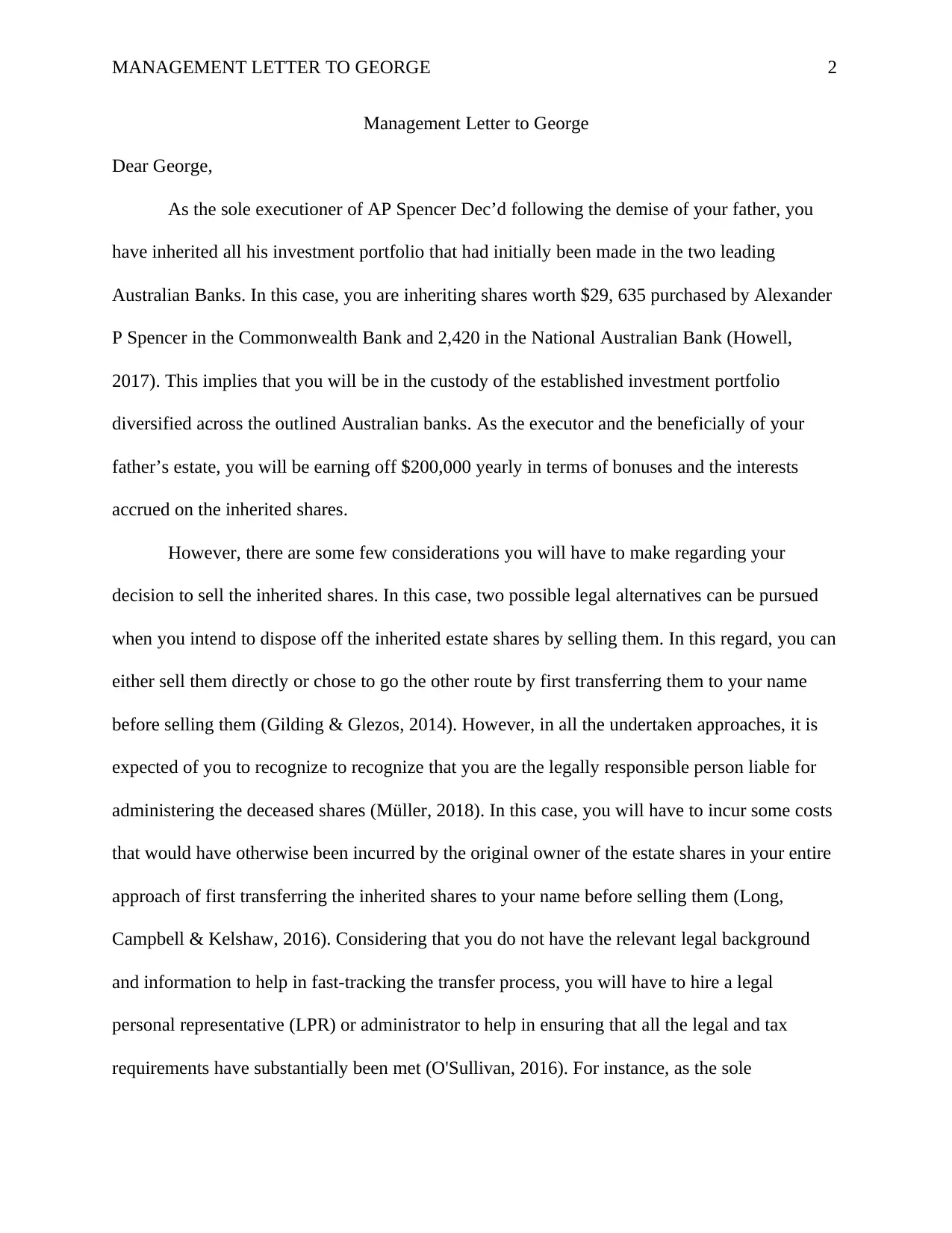
MANAGEMENT LETTER TO GEORGE 2
Management Letter to George
Dear George,
As the sole executioner of AP Spencer Dec’d following the demise of your father, you
have inherited all his investment portfolio that had initially been made in the two leading
Australian Banks. In this case, you are inheriting shares worth $29, 635 purchased by Alexander
P Spencer in the Commonwealth Bank and 2,420 in the National Australian Bank (Howell,
2017). This implies that you will be in the custody of the established investment portfolio
diversified across the outlined Australian banks. As the executor and the beneficially of your
father’s estate, you will be earning off $200,000 yearly in terms of bonuses and the interests
accrued on the inherited shares.
However, there are some few considerations you will have to make regarding your
decision to sell the inherited shares. In this case, two possible legal alternatives can be pursued
when you intend to dispose off the inherited estate shares by selling them. In this regard, you can
either sell them directly or chose to go the other route by first transferring them to your name
before selling them (Gilding & Glezos, 2014). However, in all the undertaken approaches, it is
expected of you to recognize to recognize that you are the legally responsible person liable for
administering the deceased shares (Müller, 2018). In this case, you will have to incur some costs
that would have otherwise been incurred by the original owner of the estate shares in your entire
approach of first transferring the inherited shares to your name before selling them (Long,
Campbell & Kelshaw, 2016). Considering that you do not have the relevant legal background
and information to help in fast-tracking the transfer process, you will have to hire a legal
personal representative (LPR) or administrator to help in ensuring that all the legal and tax
requirements have substantially been met (O'Sullivan, 2016). For instance, as the sole
Management Letter to George
Dear George,
As the sole executioner of AP Spencer Dec’d following the demise of your father, you
have inherited all his investment portfolio that had initially been made in the two leading
Australian Banks. In this case, you are inheriting shares worth $29, 635 purchased by Alexander
P Spencer in the Commonwealth Bank and 2,420 in the National Australian Bank (Howell,
2017). This implies that you will be in the custody of the established investment portfolio
diversified across the outlined Australian banks. As the executor and the beneficially of your
father’s estate, you will be earning off $200,000 yearly in terms of bonuses and the interests
accrued on the inherited shares.
However, there are some few considerations you will have to make regarding your
decision to sell the inherited shares. In this case, two possible legal alternatives can be pursued
when you intend to dispose off the inherited estate shares by selling them. In this regard, you can
either sell them directly or chose to go the other route by first transferring them to your name
before selling them (Gilding & Glezos, 2014). However, in all the undertaken approaches, it is
expected of you to recognize to recognize that you are the legally responsible person liable for
administering the deceased shares (Müller, 2018). In this case, you will have to incur some costs
that would have otherwise been incurred by the original owner of the estate shares in your entire
approach of first transferring the inherited shares to your name before selling them (Long,
Campbell & Kelshaw, 2016). Considering that you do not have the relevant legal background
and information to help in fast-tracking the transfer process, you will have to hire a legal
personal representative (LPR) or administrator to help in ensuring that all the legal and tax
requirements have substantially been met (O'Sullivan, 2016). For instance, as the sole
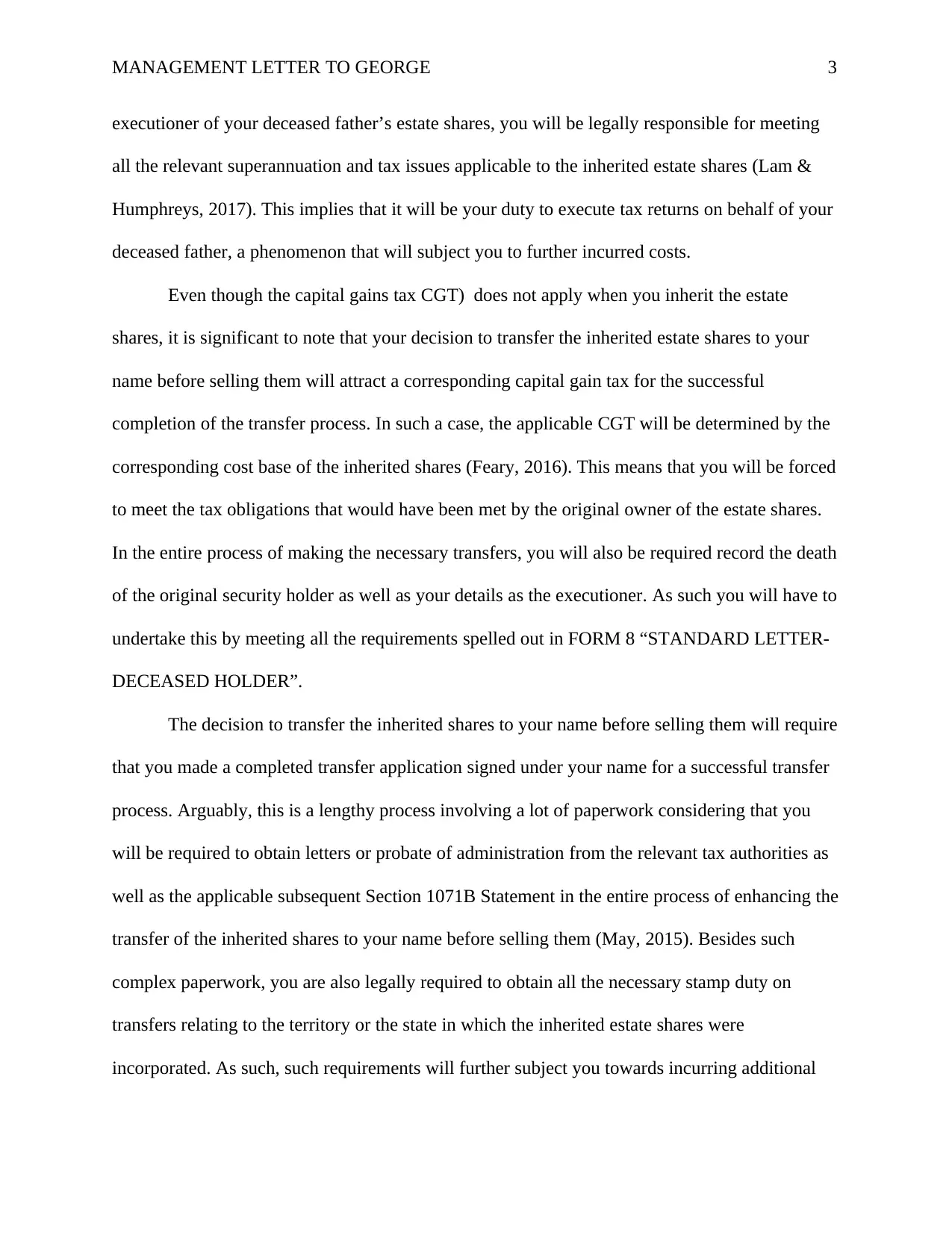
MANAGEMENT LETTER TO GEORGE 3
executioner of your deceased father’s estate shares, you will be legally responsible for meeting
all the relevant superannuation and tax issues applicable to the inherited estate shares (Lam &
Humphreys, 2017). This implies that it will be your duty to execute tax returns on behalf of your
deceased father, a phenomenon that will subject you to further incurred costs.
Even though the capital gains tax CGT) does not apply when you inherit the estate
shares, it is significant to note that your decision to transfer the inherited estate shares to your
name before selling them will attract a corresponding capital gain tax for the successful
completion of the transfer process. In such a case, the applicable CGT will be determined by the
corresponding cost base of the inherited shares (Feary, 2016). This means that you will be forced
to meet the tax obligations that would have been met by the original owner of the estate shares.
In the entire process of making the necessary transfers, you will also be required record the death
of the original security holder as well as your details as the executioner. As such you will have to
undertake this by meeting all the requirements spelled out in FORM 8 “STANDARD LETTER-
DECEASED HOLDER”.
The decision to transfer the inherited shares to your name before selling them will require
that you made a completed transfer application signed under your name for a successful transfer
process. Arguably, this is a lengthy process involving a lot of paperwork considering that you
will be required to obtain letters or probate of administration from the relevant tax authorities as
well as the applicable subsequent Section 1071B Statement in the entire process of enhancing the
transfer of the inherited shares to your name before selling them (May, 2015). Besides such
complex paperwork, you are also legally required to obtain all the necessary stamp duty on
transfers relating to the territory or the state in which the inherited estate shares were
incorporated. As such, such requirements will further subject you towards incurring additional
executioner of your deceased father’s estate shares, you will be legally responsible for meeting
all the relevant superannuation and tax issues applicable to the inherited estate shares (Lam &
Humphreys, 2017). This implies that it will be your duty to execute tax returns on behalf of your
deceased father, a phenomenon that will subject you to further incurred costs.
Even though the capital gains tax CGT) does not apply when you inherit the estate
shares, it is significant to note that your decision to transfer the inherited estate shares to your
name before selling them will attract a corresponding capital gain tax for the successful
completion of the transfer process. In such a case, the applicable CGT will be determined by the
corresponding cost base of the inherited shares (Feary, 2016). This means that you will be forced
to meet the tax obligations that would have been met by the original owner of the estate shares.
In the entire process of making the necessary transfers, you will also be required record the death
of the original security holder as well as your details as the executioner. As such you will have to
undertake this by meeting all the requirements spelled out in FORM 8 “STANDARD LETTER-
DECEASED HOLDER”.
The decision to transfer the inherited shares to your name before selling them will require
that you made a completed transfer application signed under your name for a successful transfer
process. Arguably, this is a lengthy process involving a lot of paperwork considering that you
will be required to obtain letters or probate of administration from the relevant tax authorities as
well as the applicable subsequent Section 1071B Statement in the entire process of enhancing the
transfer of the inherited shares to your name before selling them (May, 2015). Besides such
complex paperwork, you are also legally required to obtain all the necessary stamp duty on
transfers relating to the territory or the state in which the inherited estate shares were
incorporated. As such, such requirements will further subject you towards incurring additional
⊘ This is a preview!⊘
Do you want full access?
Subscribe today to unlock all pages.

Trusted by 1+ million students worldwide
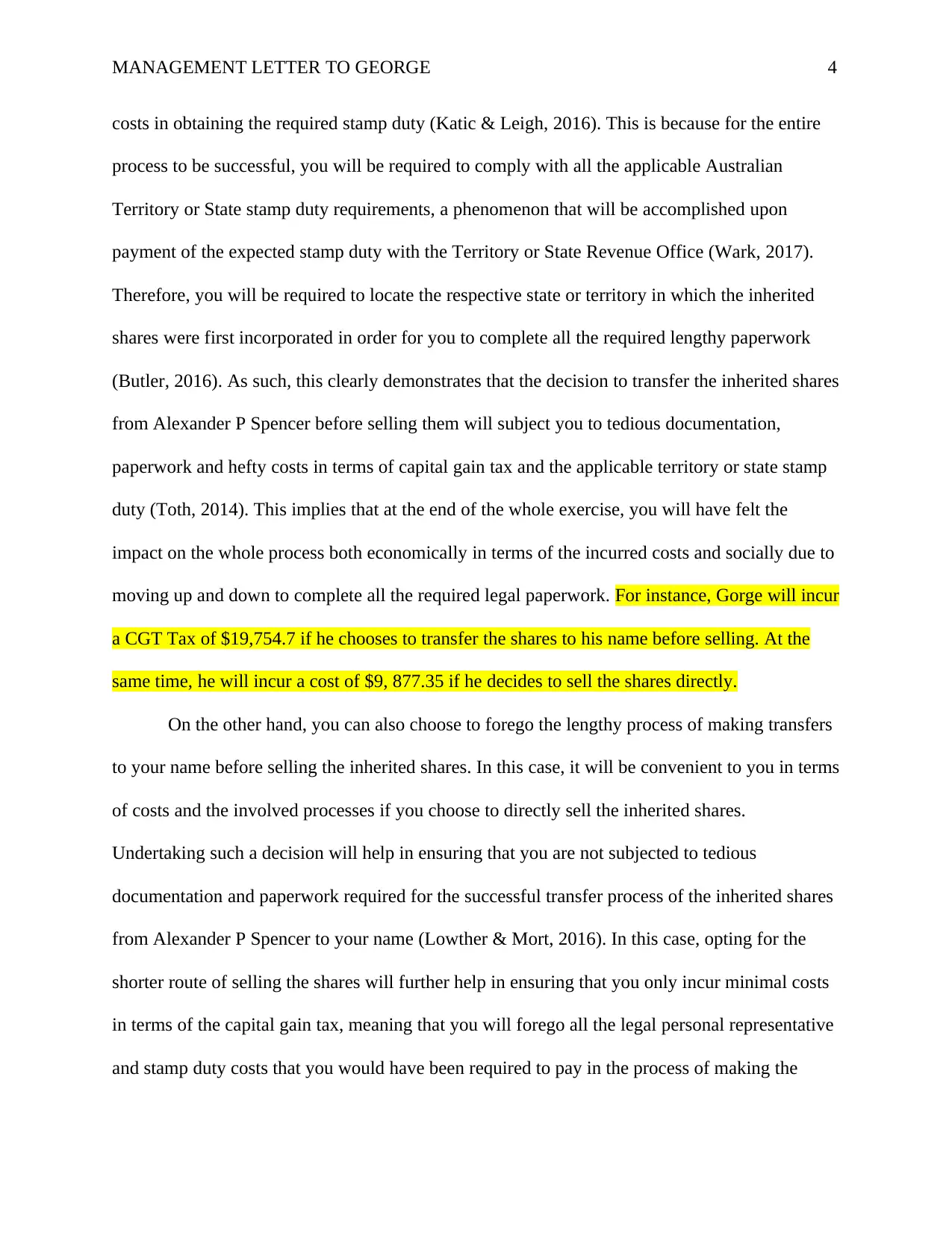
MANAGEMENT LETTER TO GEORGE 4
costs in obtaining the required stamp duty (Katic & Leigh, 2016). This is because for the entire
process to be successful, you will be required to comply with all the applicable Australian
Territory or State stamp duty requirements, a phenomenon that will be accomplished upon
payment of the expected stamp duty with the Territory or State Revenue Office (Wark, 2017).
Therefore, you will be required to locate the respective state or territory in which the inherited
shares were first incorporated in order for you to complete all the required lengthy paperwork
(Butler, 2016). As such, this clearly demonstrates that the decision to transfer the inherited shares
from Alexander P Spencer before selling them will subject you to tedious documentation,
paperwork and hefty costs in terms of capital gain tax and the applicable territory or state stamp
duty (Toth, 2014). This implies that at the end of the whole exercise, you will have felt the
impact on the whole process both economically in terms of the incurred costs and socially due to
moving up and down to complete all the required legal paperwork. For instance, Gorge will incur
a CGT Tax of $19,754.7 if he chooses to transfer the shares to his name before selling. At the
same time, he will incur a cost of $9, 877.35 if he decides to sell the shares directly.
On the other hand, you can also choose to forego the lengthy process of making transfers
to your name before selling the inherited shares. In this case, it will be convenient to you in terms
of costs and the involved processes if you choose to directly sell the inherited shares.
Undertaking such a decision will help in ensuring that you are not subjected to tedious
documentation and paperwork required for the successful transfer process of the inherited shares
from Alexander P Spencer to your name (Lowther & Mort, 2016). In this case, opting for the
shorter route of selling the shares will further help in ensuring that you only incur minimal costs
in terms of the capital gain tax, meaning that you will forego all the legal personal representative
and stamp duty costs that you would have been required to pay in the process of making the
costs in obtaining the required stamp duty (Katic & Leigh, 2016). This is because for the entire
process to be successful, you will be required to comply with all the applicable Australian
Territory or State stamp duty requirements, a phenomenon that will be accomplished upon
payment of the expected stamp duty with the Territory or State Revenue Office (Wark, 2017).
Therefore, you will be required to locate the respective state or territory in which the inherited
shares were first incorporated in order for you to complete all the required lengthy paperwork
(Butler, 2016). As such, this clearly demonstrates that the decision to transfer the inherited shares
from Alexander P Spencer before selling them will subject you to tedious documentation,
paperwork and hefty costs in terms of capital gain tax and the applicable territory or state stamp
duty (Toth, 2014). This implies that at the end of the whole exercise, you will have felt the
impact on the whole process both economically in terms of the incurred costs and socially due to
moving up and down to complete all the required legal paperwork. For instance, Gorge will incur
a CGT Tax of $19,754.7 if he chooses to transfer the shares to his name before selling. At the
same time, he will incur a cost of $9, 877.35 if he decides to sell the shares directly.
On the other hand, you can also choose to forego the lengthy process of making transfers
to your name before selling the inherited shares. In this case, it will be convenient to you in terms
of costs and the involved processes if you choose to directly sell the inherited shares.
Undertaking such a decision will help in ensuring that you are not subjected to tedious
documentation and paperwork required for the successful transfer process of the inherited shares
from Alexander P Spencer to your name (Lowther & Mort, 2016). In this case, opting for the
shorter route of selling the shares will further help in ensuring that you only incur minimal costs
in terms of the capital gain tax, meaning that you will forego all the legal personal representative
and stamp duty costs that you would have been required to pay in the process of making the
Paraphrase This Document
Need a fresh take? Get an instant paraphrase of this document with our AI Paraphraser
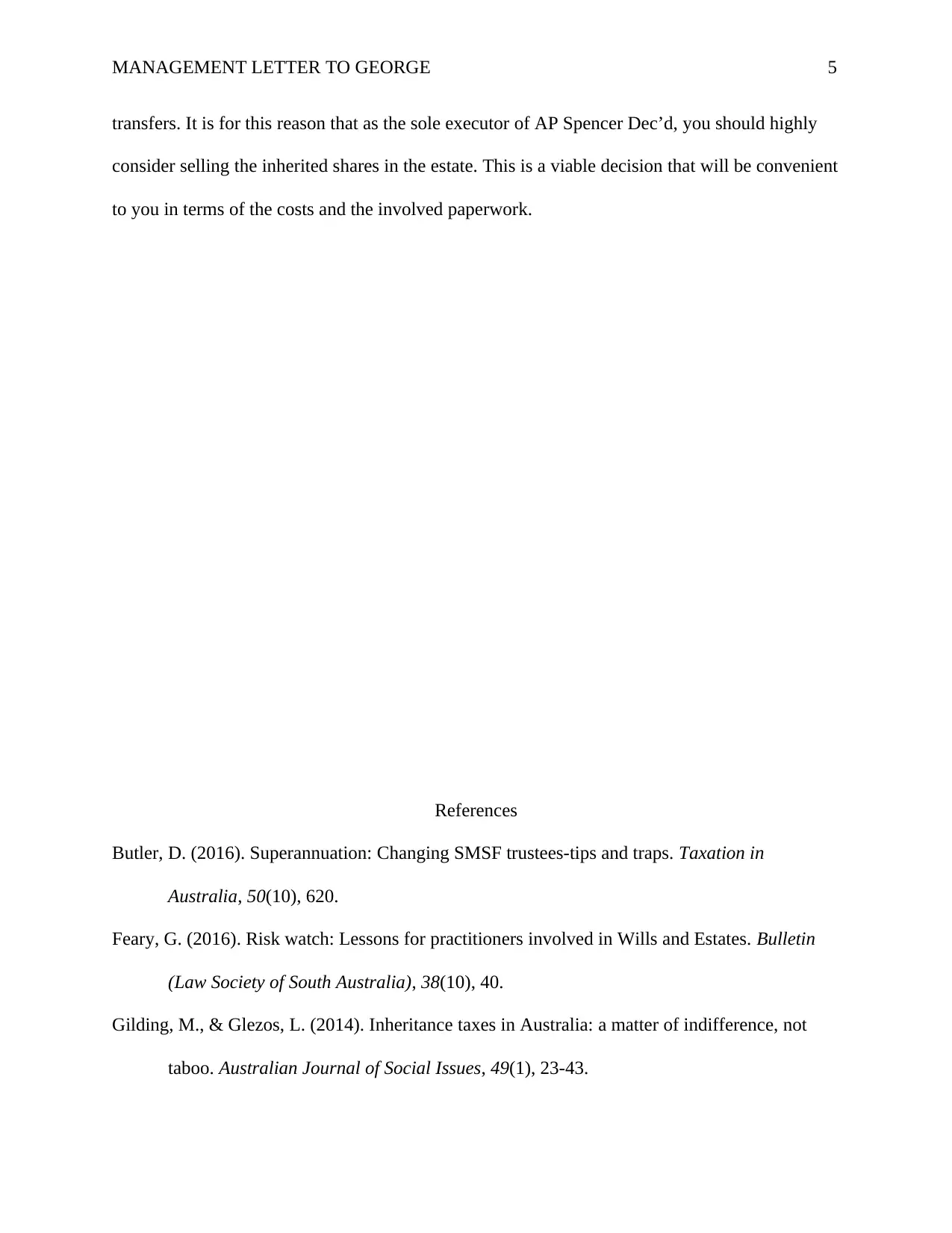
MANAGEMENT LETTER TO GEORGE 5
transfers. It is for this reason that as the sole executor of AP Spencer Dec’d, you should highly
consider selling the inherited shares in the estate. This is a viable decision that will be convenient
to you in terms of the costs and the involved paperwork.
References
Butler, D. (2016). Superannuation: Changing SMSF trustees-tips and traps. Taxation in
Australia, 50(10), 620.
Feary, G. (2016). Risk watch: Lessons for practitioners involved in Wills and Estates. Bulletin
(Law Society of South Australia), 38(10), 40.
Gilding, M., & Glezos, L. (2014). Inheritance taxes in Australia: a matter of indifference, not
taboo. Australian Journal of Social Issues, 49(1), 23-43.
transfers. It is for this reason that as the sole executor of AP Spencer Dec’d, you should highly
consider selling the inherited shares in the estate. This is a viable decision that will be convenient
to you in terms of the costs and the involved paperwork.
References
Butler, D. (2016). Superannuation: Changing SMSF trustees-tips and traps. Taxation in
Australia, 50(10), 620.
Feary, G. (2016). Risk watch: Lessons for practitioners involved in Wills and Estates. Bulletin
(Law Society of South Australia), 38(10), 40.
Gilding, M., & Glezos, L. (2014). Inheritance taxes in Australia: a matter of indifference, not
taboo. Australian Journal of Social Issues, 49(1), 23-43.
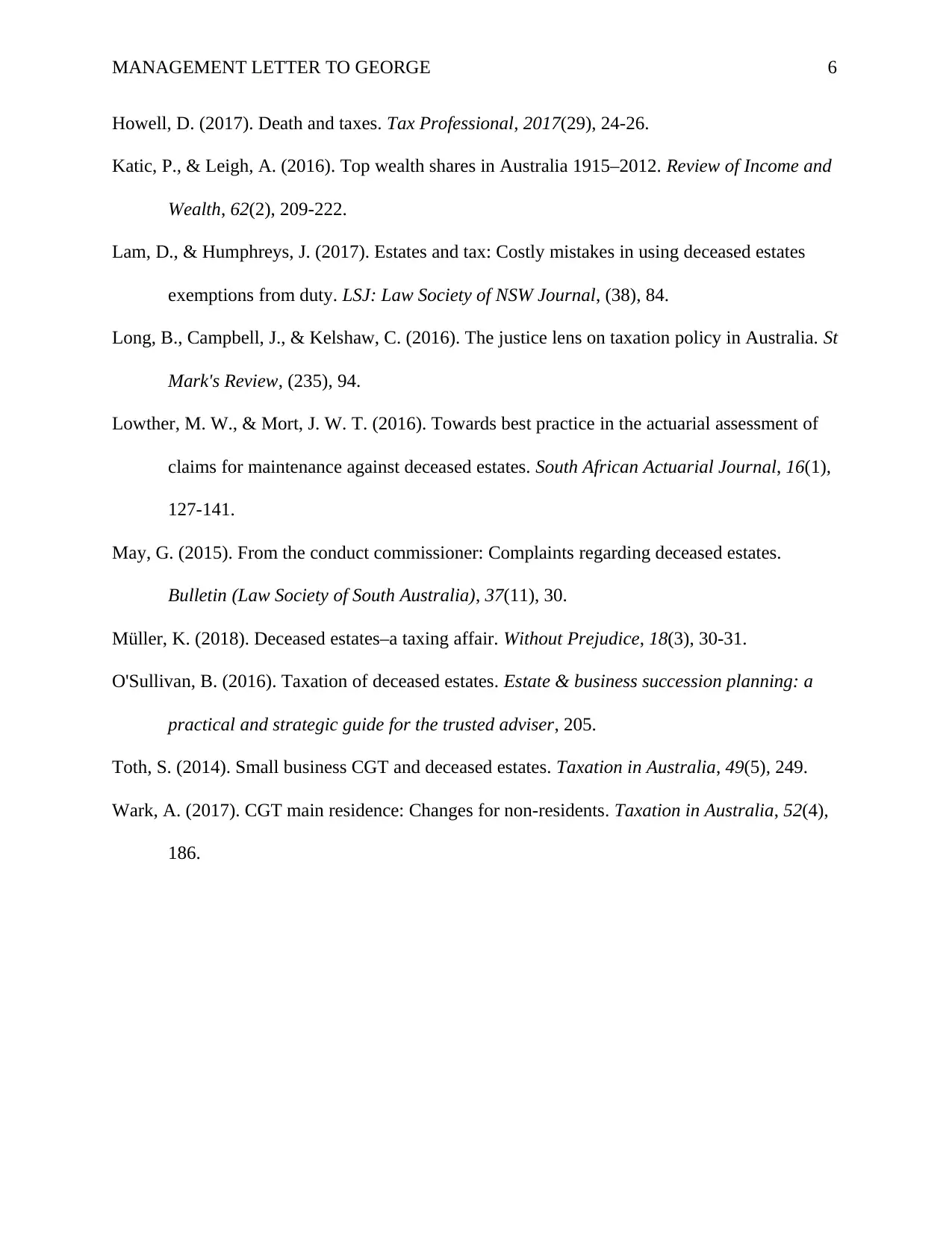
MANAGEMENT LETTER TO GEORGE 6
Howell, D. (2017). Death and taxes. Tax Professional, 2017(29), 24-26.
Katic, P., & Leigh, A. (2016). Top wealth shares in Australia 1915–2012. Review of Income and
Wealth, 62(2), 209-222.
Lam, D., & Humphreys, J. (2017). Estates and tax: Costly mistakes in using deceased estates
exemptions from duty. LSJ: Law Society of NSW Journal, (38), 84.
Long, B., Campbell, J., & Kelshaw, C. (2016). The justice lens on taxation policy in Australia. St
Mark's Review, (235), 94.
Lowther, M. W., & Mort, J. W. T. (2016). Towards best practice in the actuarial assessment of
claims for maintenance against deceased estates. South African Actuarial Journal, 16(1),
127-141.
May, G. (2015). From the conduct commissioner: Complaints regarding deceased estates.
Bulletin (Law Society of South Australia), 37(11), 30.
Müller, K. (2018). Deceased estates–a taxing affair. Without Prejudice, 18(3), 30-31.
O'Sullivan, B. (2016). Taxation of deceased estates. Estate & business succession planning: a
practical and strategic guide for the trusted adviser, 205.
Toth, S. (2014). Small business CGT and deceased estates. Taxation in Australia, 49(5), 249.
Wark, A. (2017). CGT main residence: Changes for non-residents. Taxation in Australia, 52(4),
186.
Howell, D. (2017). Death and taxes. Tax Professional, 2017(29), 24-26.
Katic, P., & Leigh, A. (2016). Top wealth shares in Australia 1915–2012. Review of Income and
Wealth, 62(2), 209-222.
Lam, D., & Humphreys, J. (2017). Estates and tax: Costly mistakes in using deceased estates
exemptions from duty. LSJ: Law Society of NSW Journal, (38), 84.
Long, B., Campbell, J., & Kelshaw, C. (2016). The justice lens on taxation policy in Australia. St
Mark's Review, (235), 94.
Lowther, M. W., & Mort, J. W. T. (2016). Towards best practice in the actuarial assessment of
claims for maintenance against deceased estates. South African Actuarial Journal, 16(1),
127-141.
May, G. (2015). From the conduct commissioner: Complaints regarding deceased estates.
Bulletin (Law Society of South Australia), 37(11), 30.
Müller, K. (2018). Deceased estates–a taxing affair. Without Prejudice, 18(3), 30-31.
O'Sullivan, B. (2016). Taxation of deceased estates. Estate & business succession planning: a
practical and strategic guide for the trusted adviser, 205.
Toth, S. (2014). Small business CGT and deceased estates. Taxation in Australia, 49(5), 249.
Wark, A. (2017). CGT main residence: Changes for non-residents. Taxation in Australia, 52(4),
186.
⊘ This is a preview!⊘
Do you want full access?
Subscribe today to unlock all pages.

Trusted by 1+ million students worldwide
1 out of 6
Related Documents
Your All-in-One AI-Powered Toolkit for Academic Success.
+13062052269
info@desklib.com
Available 24*7 on WhatsApp / Email
![[object Object]](/_next/static/media/star-bottom.7253800d.svg)
Unlock your academic potential
Copyright © 2020–2025 A2Z Services. All Rights Reserved. Developed and managed by ZUCOL.




